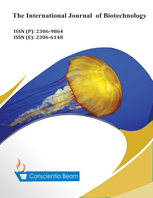Comparing Patatin Class I and Camv 35s Promoters in Expression of Human Calcitonin Gene in Potato (Solanum Tuberosum Cvs. Kardal And Marfona)
DOI:
https://doi.org/10.18488/journal.57/2016.5.4/57.4.52.61Abstract
Calcitonin (CT), a 32 amino acid polypeptide hormone is a powerful and specific inhibitor of bone resorption and is used to treat several human diseases like hypercalcemia and osteoporosis. To date, many pharmaceutical proteins of mammalian origin have been synthesized in plants. To increase the production level of heterologous proteins in plants, strategies such as choice of stronger promoters and optimization of codon usage are of major concern. In this study, a human calcitonin (hCT) gene, driven by two different promoters (Patatin Class I and Cauliflower mosaic virus 35S) was expressed in two types of potato's cultivars (cvs) Kardal and Marfona plants, using Agrobacterium-mediated transformation. The transgenic plants were analyzed by molecular methods and hCT concentration was determined by quantitative EASIA. The results showed the localization of hCT production in Kardal potato tubers led to 0.7% of total soluble proteins whiles total soluble protein was 0.2% when CaMV 35S promoter was deployed, these results of Marfona when used Patatin Class I and Cauliflower mosaic virus 35S promoters were 0.3% of the total soluble protein and 0.1% of the total soluble protein in the respect. Data were analyzed by SPSS software using analytical statistics. There was significant difference in mean score of hCT production when two different promoters and two different cultivars were used. These results showed that organ specific expression in potato led to nearly 3 fold higher hCT accumulation than constitutive expression and Kardal cultivar expressed hCT about 2 times higher than Marfona cultivar.

